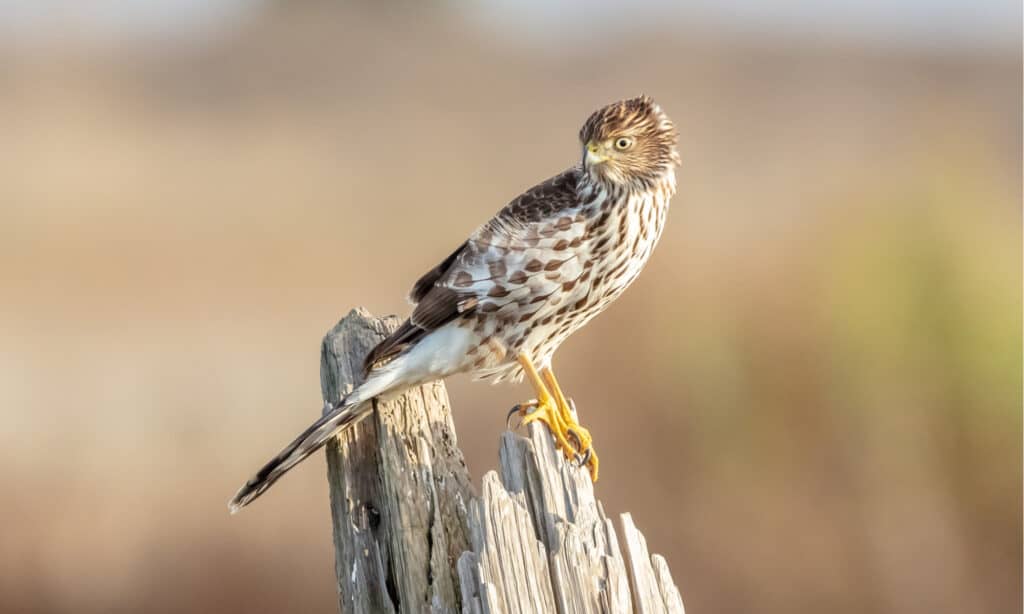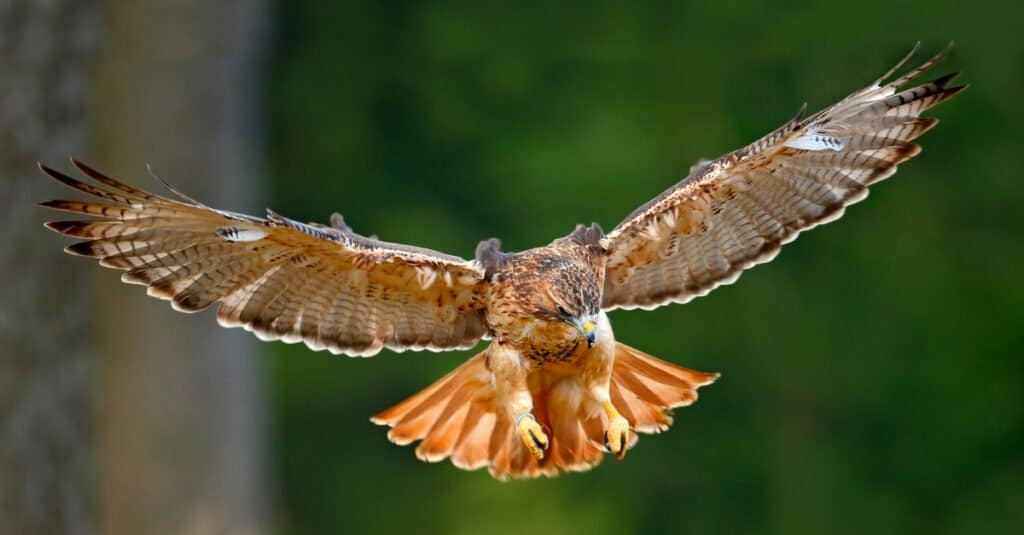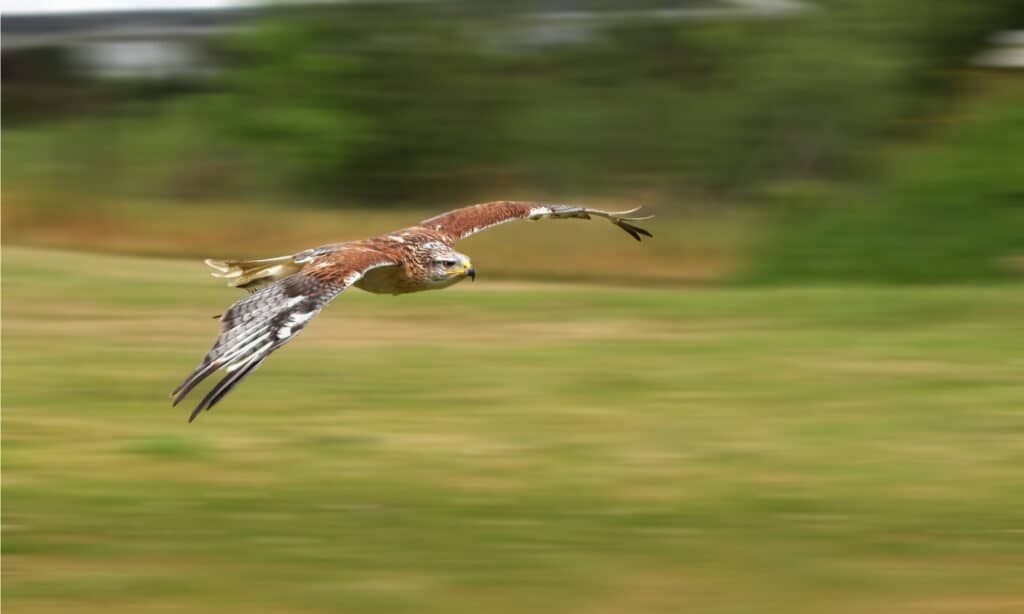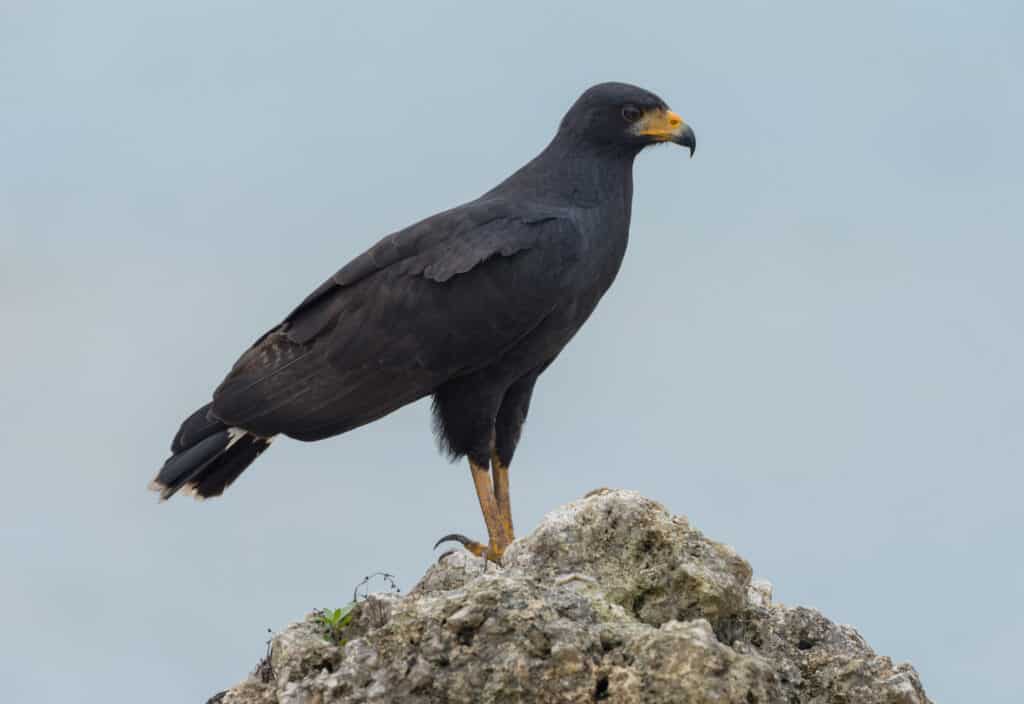Home of the Everglades, Florida is one of the top destinations in the United States regarding bird watching. You can find around 196 different types of birds, including these eight types of hawks, in Florida.
Whether you’re preparing to visit this birding paradise or just want to learn more about the types of hawks in Florida, keep reading!

1. Sharp-Shinned Hawk
| Scientific Name | Accipiter striatus |
| Weight | 2.9 – 7.7 ounces |
| Length | 9 to 15 inches |
| Wingspan | 17 to 27 inches |
The sharp-shinned hawk is the smallest hawk in Florida. It is also considered the smallest hawk in all of the United States. However, its small size doesn’t stop it from being a top bird of prey!
Sharp-shinned hawks can be found in the forests of Florida. Here, they hunt other small birds by hiding in the bushes and ambushing them. By utilizing ambush tactics, sharp-shinned hawks can use their small size to their advantage.
Despite living in forests, however, sharp-shinned hawks are often a common sight around homes. This is because they like to frequent bird feeders, where small birds often flock. Some common prey for sharp-shinned hawks are bluejays, doves, chickadees, and other small types of birds in Florida. They may also hunt small rodents, reptiles, amphibians, and even mammals like bats.
Sharp-shinned hawks can be identified by their bluish-gray backs and rust-white colored bellies. They’re compact, fast, and can often be seen darting across the sky.

The sharp-shinned hawk is the smallest hawk!
©Pierre Leclerc/Shutterstock.com
2. Northern Harrier
| Scientific Name | Circus hudsonius |
| Weight | 0.6 to 1.6 pounds |
| Length | 16 to 20 inches |
| Wingspan | 38 to 48 inches |
The northern harrier tends to spend much of the year up north. However, as winter comes, they become a more common sight in southern states, including Florida.
One of the unique characteristics of the northern harrier is its face. While many hawks have a noticeable sharp, narrow face, northern harriers have a flat face. In fact, they’re often mistaken for owls! Just like with owls, however, this flat face shape helps northern harriers hear, making them expert hunters.

The northern harrier is easily mistaken for an owl.
©Harry Collins Photography/Shutterstock.com
3. Red-Tailed Hawk
| Scientific Name | Buteo jamaicensis |
| Weight | 1.6- 3.5 pounds |
| Length | 18 – 26 inches |
| Wingspan | 40.8 – 57.6 inches |
The red-tailed hawk is easily one of the most common hawks in the United States. It can be found in almost every state year-round. Even though it tends to fly south for the winter, it can still be found in states as far north as even Minnesota!
When you think of hawks, red-tailed hawks are probably the ones that come to mind first. Although they can be easily confused with the red-shouldered hawk, you can tell them apart by their size and color. The red-tailed hawk is large. It also has a dark brown band across its stomach, while the red-shouldered hawk has a rust-colored belly.
There are fourteen subspecies of red-tailed hawks in the world. One, the Florida red-tailed hawk (B. j. umbrinus), is a native type of hawk in Florida. You can find it year-round in Florida. It has a slightly larger wingspan than the most common red-tailed hawk, the eastern red-tailed hawk (B. j. borealis).
Another reason that red-tailed hawks are one of the most well-known hawks is their role in falconry. Falconry is a type of hunting sport in which a bird of prey, usually a hawk or falcon, is used to hunt small prey. Birds used in falconry are wild-caught, but there are many rules and regulations to help keep the populations safe. Because their diet is mainly made up of small mammals like mice, squirrels, and even rabbits, they excel at this sport.

The red-tailed hawk’s distinct tail feathers are a result of the molting process.
©Ondrej Prosicky/Shutterstock.com
4. Cooper’s Hawk
| Scientific Name | Accipiter cooperii |
| Weight | 1.2 pounds |
| Length | 14 – 20 inches |
| Wingspan | 24 – 39 inches |
Cooper’s hawks have many names, including big blue darter, chicken hawk, flying cross, hen hawk, quail hawk, and swift hawk. Many of these names have come from their impressive hunting abilities.
While most hawks aren’t picky when it comes to meals, Cooper’s hawks truly go above and beyond. Scientists have estimated them to eat as many as 300 different species. They’re even skilled at hunting other birds midair!

Cooper’s hawks have an interesting banding pattern on their wings and backs.
©Richard G Smith/Shutterstock.com
5. Short-Tailed Hawk
| Scientific Name | Buteo brachyurus |
| Weight | 13.6 to 16.9 ounces |
| Length | 15.3 to 17.3 inches |
| Wingspan | 32.7 to 40.5 inches |
In the United States, short-tailed hawks are a rare sight. Typically, they’re found in subtropical woodlands, which are found most often in Central and South America. However, there is an isolated population that you can find right in Florida. Here, they breed in the central part of the state before returning to their year-round home in the Everglades.
Compared to other types of hawks in Florida, short-tailed hawks are relatively small. As adults, they’re around the size of a crow, making them medium-sized birds. Depending on their region, they can have light or dark morphs (colors).
Do you know one of the most surprising features of these birds is their diet? Their diet mostly consists of other birds! Short-tailed hawks eat diets mainly composed of small songbirds and even smaller hawks, like the sharp-shinned hawk. However, because they live in the Everglades, they may also eat small reptiles and amphibians.

Short-tailed hawks are typically found in subtropical woodlands.
©iStock.com/Nikola Art
6. Broad-Winged Hawk
| Scientific Name | Buteo playpterus |
| Weight | Around 1 pound |
| Length | Around 34 inches |
| Wingspan | Around 16 inches |
Broad-winged hawks spend most of the year in eastern North America. When winter comes, however, many move further south into an area known as the Neotropics. This includes regions in Mexico to as far south as Southern Brazil.
Broad-winged hawks are another common type of hawk in Florida. Some researchers estimate that around one million of these birds of prey live in North America alone.
While they’re not the smallest hawk, broad-winged hawks are the smallest of the Buteo family found in North America. They can be identified by their dark bodies with white markings. They have a widely diverse diet, eating everything from small mammals to amphibians and reptiles to insects. They’re even known to snack on earthworms.

The broad-winged hawk spends most of the year in eastern North America.
©pr2is/Shutterstock.com
7. Great Black Hawk
| Scientific Name | Buteogallus urubitinga |
| Weight | 2 to 3 pounds |
| Length | 22 to 25 inches |
| Wingspan | Around 50 inches. |
Great black hawks are often found in warmer climates, such as South and Central America, as well as the islands of Trinidad and Tobago. However, they are also a type of hawk in Florida, thanks to the warmer weather there. They can be a rare sight that far north, though.
One has been found as far north as Maine, where it’s become a bit of a state-wide celebrity.
Great black hawks tend to only eat reptiles and large insects, which they often hunt on foot. Occasionally, they can be seen raiding bird nests along the Amazon River. Here, they look for eggs and chicks of a bird known as the hoatzin. There are two subspecies of great black hawks, B. u. ridgwayi and B. u. urubitinga. Another name for the great black hawk is the Brazilian eagle.

Black hawks are found in warm areas in the far south.
©iStock.com/Rainer Lesniewski
8. Red-Shouldered Hawk
| Scientific Name | Buteo lineatus |
| Weight | 1.3 pounds |
| Length | 15 –19 inches |
| Wingspan | 37– 42 inches |
Like red-tailed hawks, red-shouldered hawks are among the most common types of hawks in Florida, as well as the rest of the United States. They can be identified by their smaller size compared to the red-tailed hawk and rust-colored bellies. They’re also known for their long lifespans, reaching nearly thirty years old in the wild.
One reason red-shouldered hawks are able to thrive in such a diverse region is because of their diet. Like most types of hawks in Florida, red-shouldered hawks eat small mammals like rabbits, squirrels, and rodents. However, their diet is much broader than that! They have even been known to eat snakes, frogs, and even crayfish.

Red-shouldered hawks can be identified by their red stomachs.
©Nick Bossenbroek/Shutterstock.com
Summary of 8 Types of Hawks in Florida
| Name | Habitat | Prey |
|---|---|---|
| Sharp-shinned Hawk | Deepest ends of dense forests. | Small birds; also small rodents, reptiles, amphibians, and bats. |
| Northern Harrier | Small birds, also small rodents, reptiles, amphibians, and bats. | Mostly small birds and small mammals. |
| Red-tailed Hawk | Hunt in open fields; build nests on top of the tallest buildings, cliff ledges, and tallest trees. | Mainly small mammals. |
| Cooper’s Hawk | Woodland canopies. | Dense, unbroken deciduous, or mixed deciduous/coniferous woodlands. |
| Short-tailed Hawk | Subtropical woodlands. | Small songbirds and smaller hawks. |
| Broad-winged Hawk | Dense, unbroken deciduous or mixed deciduous/coniferous woodlands. | Small mammals, amphibians, reptiles, and insects. |
| Great Black Hawk | Mainly coastal areas, but also forests and open woodlands near water. | Reptiles and large insects. |
| Red-Shouldered Hawk | Suburban areas, wooden swamps, and deciduous forests. | Small mammals. |
The photo featured at the top of this post is © pr2is/Shutterstock.com
Thank you for reading! Have some feedback for us? Contact the AZ Animals editorial team.






